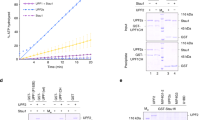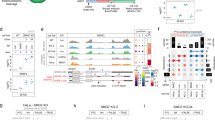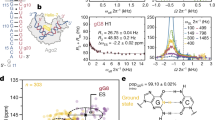Abstract
We report a new mechanism by which human mRNAs cross-talk: an Alu element in the 3′ untranslated region (3′ UTR) of one mRNA can base-pair with a partially complementary Alu element in the 3′ UTR of a different mRNA, thereby creating a Staufen1 (STAU1)-binding site (SBS). STAU1 binding to a 3′-UTR SBS was previously shown to trigger STAU1-mediated mRNA decay (SMD) by directly recruiting the ATP-dependent RNA helicase UPF1, which is also a key factor in the mechanistically related nonsense-mediated mRNA decay (NMD) pathway. In the case of a 3′-UTR SBS created by mRNA-mRNA base-pairing, we show that SMD targets both mRNAs in the duplex, provided that both mRNAs are translated. If only one mRNA is translated, then it alone is targeted for SMD. We demonstrate the functional importance of mRNA–mRNA–triggered SMD in cell migration and invasion.
This is a preview of subscription content, access via your institution
Access options
Subscribe to this journal
Receive 12 print issues and online access
$189.00 per year
only $15.75 per issue
Buy this article
- Purchase on Springer Link
- Instant access to full article PDF
Prices may be subject to local taxes which are calculated during checkout





Similar content being viewed by others
Change history
04 December 2013
In the version of this article initially published, the last sentence of the Figure 5 legend reads: "Downregulation of SOWAHC mRNA inhibits SOWAHC mRNA-CDCP1 mRNA base-pairing and thus the SOWAHC mRNA-mediated SMD of CDCP1 mRNA, an mRNA that encodes a protein that inhibits cell migration and invasion." However, "a protein that inhibits" should have read "a protein that promotes." The error has been corrected in the HTML and PDF versions of the article.
References
Gong, C., Kim, Y.K., Woeller, C.F., Tang, Y. & Maquat, L.E. SMD and NMD are competitive pathways that contribute to myogenesis: effects on PAX3 and myogenin mRNAs. Genes Dev. 23, 54–66 (2009).
Gong, C. & Maquat, L.E. lncRNAs transactivate STAU1-mediated mRNA decay by duplexing with 3′ UTRs via Alu elements. Nature 470, 284–288 (2011).
Cho, H. et al. Staufen1-mediated mRNA decay functions in adipogenesis. Mol. Cell 46, 495–506 (2012).
Park, E. & Maquat, L.E. Staufen-mediated mRNA decay. Wiley Interdiscip. Rev. RNA 4, 423–435 (2013).
Kim, Y.K. et al. Staufen1 regulates diverse classes of mammalian transcripts. EMBO J. 26, 2670–2681 (2007).
Eferl, R. & Wagner, E.F. AP-1: a double-edged sword in tumorigenesis. Nat. Rev. Cancer 3, 859–868 (2003).
Shaulian, E. & Karin, M. AP-1 as a regulator of cell life and death. Nat. Cell Biol. 4, E131–E136 (2002).
Kim, Y.K., Furic, L., DesGroseillers, L. & Maquat, L.E. Mammalian Staufen1 recruits Upf1 to specific mRNA 3′ UTRs so as to elicit mRNA decay. Cell 120, 195–208 (2005).
Miyazawa, Y. et al. CUB domain-containing protein 1, a prognostic factor for human pancreatic cancers, promotes cell migration and extracellular matrix degradation. Cancer Res. 70, 5136–5146 (2010).
Schmitz, J. SINEs as driving forces in genome evolution. Genome Dyn. 7, 92–107 (2012).
Wang, J., Gong, C. & Maquat, L.E. Control of myogenesis by rodent SINE-containing lncRNAs. Genes Dev. 27, 793–804 (2013).
Maquat, L.E., Tarn, W.Y. & Isken, O. The pioneer round of translation: features and functions. Cell 142, 368–374 (2010).
Park, E., Gleghorn, M.L. & Maquat, L.E. Staufen2 functions in Staufen1-mediated mRNA decay by binding to itself and its paralog and promoting UPF1 helicase but not ATPase activity. Proc. Natl. Acad. Sci. USA 110, 405–412 (2013).
Chamieh, H., Ballut, L., Bonneau, F. & Le Hir, H. NMD factors UPF2 and UPF3 bridge UPF1 to the exon junction complex and stimulate its RNA helicase activity. Nat. Struct. Mol. Biol. 15, 85–93 (2008).
Melero, R. et al. The cryo-EM structure of the UPF–EJC complex shows UPF1 poised toward the RNA 3′ end. Nat. Struct. Mol. Biol. 19, 498–505 (2012).
Gehring, N.H. et al. Exon-junction complex components specify distinct routes of nonsense-mediated mRNA decay with differential cofactor requirements. Mol. Cell 20, 65–75 (2005).
Kunz, J.B., Neu-Yilik, G., Hentze, M.W., Kulozik, A.E. & Gehring, N.H. Functions of hUpf3a and hUpf3b in nonsense-mediated mRNA decay and translation. RNA 12, 1015–1022 (2006).
Gleghorn, M.L., Gong, C., Kielkopf, C.L. & Maquat, L.E. Staufen1 dimerizes through a conserved motif and a degenerate dsRNA-binding domain to promote mRNA decay. Nat. Struct. Mol. Biol. 20, 515–524 (2013).
Martel, C. et al. Multimerization of Staufen1 in live cells. RNA 16, 585–597 (2010).
Reuter, J.S. & Mathews, D.H. RNAstructure: software for RNA secondary structure prediction and analysis. BMC Bioinformatics 11, 129 (2010).
Gong, C., Popp, M.W. & Maquat, L.E. Biochemical analysis of long non-coding RNA-containing ribonucleoprotein complexes. Methods 58, 88–93 (2012).
Huang, L. & Wilkinson, M.F. Regulation of nonsense-mediated mRNA decay. Wiley Interdiscip. Rev. RNA 3, 807–828 (2012).
Lipson, S.E. & Hearst, J.E. Psoralen cross-linking of ribosomal RNA. Methods Enzymol. 164, 330–341 (1988).
Gong, C. & Maquat, L.E. “Alu”strious long ncRNAs and their role in shortening mRNA half-lives. Cell Cycle 10, 1882–1883 (2011).
Ingolia, N.T., Lareau, L.F. & Weissman, J.S. Ribosome profiling of mouse embryonic stem cells reveals the complexity and dynamics of mammalian proteomes. Cell 147, 789–802 (2011).
Sato, H. & Maquat, L.E. Remodeling of the pioneer translation initiation complex involves translation and the karyopherin importin β. Genes Dev. 23, 2537–2550 (2009).
Cesana, M. et al. A long noncoding RNA controls muscle differentiation by functioning as a competing endogenous RNA. Cell 147, 358–369 (2011).
Karreth, F.A. et al. In vivo identification of tumor-suppressive PTEN ceRNAs in an oncogenic BRAF-induced mouse model of melanoma. Cell 147, 382–395 (2011).
Rubio-Somoza, I., Weigel, D., Franco-Zorilla, J.M., García, J.A. & Paz-Ares, J. ceRNAs: miRNA target mimic mimics. Cell 147, 1431–1432 (2011).
Sumazin, P. et al. An extensive microRNA-mediated network of RNA-RNA interactions regulates established oncogenic pathways in glioblastoma. Cell 147, 370–381 (2011).
Tay, Y. et al. Coding-independent regulation of the tumor suppressor PTEN by competing endogenous mRNAs. Cell 147, 344–357 (2011).
Di Giammartino, D.C., Nishida, K. & Manley, J.L. Mechanisms and consequences of alternative polyadenylation. Mol. Cell 43, 853–866 (2011).
Elbarbary, R.A., Li, W., Tian, B. & Maquat, L.E. STAU1 binding to 3′ UTR IRAlus complements nuclear retention to protect cells from PKR-mediated translational shutdown. Genes Dev. 27, 1495–1510 (2013).
Marión, R.M., Fortes, P., Beloso, A., Dotti, C. & Ortín, J. A human sequence homologue of Staufen is an RNA-binding protein that is associated with polysomes and localizes to the rough endoplasmic reticulum. Mol. Cell. Biol. 19, 2212–2219 (1999).
Acknowledgements
We thank D. Mathews for computational advice, K. Nehrke for access to his inverted fluorescence microscope, S. de Lucas and J. Ortín (Centro Nacional de Biotecnología, Madrid, Spain) for anti-STAU1 antibody, C. Beckham for help with the trans-well assay and M.W.-L. Popp for comments on the manuscript. This work was supported by the US National Institutes of Health (GM074593 to L.E.M.) and a University of Rochester Messersmith Graduate Student Fellowship (C.G.).
Author information
Authors and Affiliations
Contributions
C.G. wrote the Perl programs and undertook the bioinformatics analyses and performed, with assistance from Y.T., wet-bench experiments. C.G. and L.E.M. designed the experiments, analyzed experimental data and wrote the manuscript.
Corresponding author
Ethics declarations
Competing interests
The authors declare no competing financial interests.
Supplementary information
Supplementary Text and Figures
Supplementary Figures 1–6 (PDF 2693 kb)
Supplementary Table 1
△G of predicted duplexes formed between the 3′UTR Alu element of each specified ensembl transcript and the 3′UTR Alu element of each of three proven SMD targets (XLS 375 kb)
Supplementary Table 3
Length of 3′UTR and siRNA annealing site(s) for each analyzed mRNA (XLS 22 kb)
Supplementary Table 3
Primers used in RT-sqPCR or RT-qPCR (XLS 22 kb)
Rights and permissions
About this article
Cite this article
Gong, C., Tang, Y. & Maquat, L. mRNA–mRNA duplexes that autoelicit Staufen1-mediated mRNA decay. Nat Struct Mol Biol 20, 1214–1220 (2013). https://doi.org/10.1038/nsmb.2664
Received:
Accepted:
Published:
Issue Date:
DOI: https://doi.org/10.1038/nsmb.2664
This article is cited by
-
Measuring and interpreting transposable element expression
Nature Reviews Genetics (2020)
-
Insights into the assembly and architecture of a Staufen-mediated mRNA decay (SMD)-competent mRNP
Nature Communications (2019)
-
Kruppel-like factor 4-dependent Staufen1-mediated mRNA decay regulates cortical neurogenesis
Nature Communications (2018)
-
ADAR1 controls apoptosis of stressed cells by inhibiting Staufen1-mediated mRNA decay
Nature Structural & Molecular Biology (2017)
-
Using hiCLIP to identify RNA duplexes that interact with a specific RNA-binding protein
Nature Protocols (2017)



